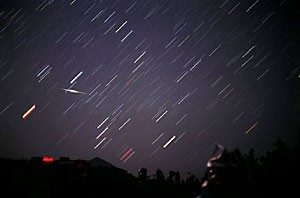If you have spent your life looking for a shooting star to wish on, look no further than the Tucson night sky this weekend.
Starting Saturday night, the Perseid meteor shower should be visible if the weather is clear. The meteor shower occurs annually and is a result of debris from the Swift-Tuttle comet.
“”It is one of the best meteor showers of the year,”” said Michael Magee, senior media specialist at the UA’s Flandrau Science Center.
Debris from the comet is created when it comes close to the sun. Particles of dust form a long trail behind the comet. This debris consists of tiny particles of rock, some no larger than a grain of sand. Most burn up in the Earth’s atmosphere.
The shower is expected to last four days, with at least 10-30 visible meteors per hour.
The Flandrau Science Center will be holding a special presentation to help educate the public about the meteor shower. It will begin with a presentation of “”More than Meets the Eye,”” a planetarium show that will talk about the Perseids and other showers.
Thomas Fleming, an astronomer at the Steward Observatory and a lecturer at the UA, will attend to advise those present on where to go and what to watch for, Magee said.
Fleming will follow the planetarium show with a lecture about the Perseids and where the best places in Tucson is to observe it.
Recommended sites to view the showers include Saguaro National Park on East Speedway Boulevard and the Tucson Mountain Park, 8451 W. McCain Loop. Watchers should find a place far from the city lights and look for the showers in the high eastern areas of the sky. Best viewing times should occur after 10 p.m.
The Flandrau Center is located on the northeast corner of North Cherry Avenue and East University Boulevard. The presentation begins at 8 p.m. Admission is $5 for adults and children over the age of 4. For more information, contact Flandrau Science Center at 621-4310 or visit www.flandrau.org/astronomy/skywatchers.









